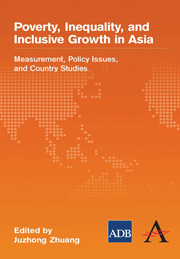Book contents
- Frontmatter
- Contents
- Foreword
- Preface and Acknowledgments
- Contributors
- Abbreviations, Acronyms, and Symbols
- Tables, Figures, and Boxes
- 1 Poverty, Inequality, and Inclusive Growth in Asia
- Part A Measuring Inequality and Poverty
- Part B Selected Policy Issues for Inclusive Growth
- Part C Country Studies
- 9 Growth, Inequality, and the Labor Market: The Philippines
- 10 Poverty and Inequality in Nepal: An Empirical Analysis
- 11 Decomposing Income Inequality: People's Republic of China, 1990–2005
- 12 Evolution of Income Mobility: People's Republic of China, 1991–2002
- 13 Occupational Segregation and Gender Discrimination in Labor Markets: Thailand and Viet Nam
- 14 Inclusiveness through Food Security: The Philippines' National Food Program
- Index
9 - Growth, Inequality, and the Labor Market: The Philippines
from Part C - Country Studies
Published online by Cambridge University Press: 05 March 2012
- Frontmatter
- Contents
- Foreword
- Preface and Acknowledgments
- Contributors
- Abbreviations, Acronyms, and Symbols
- Tables, Figures, and Boxes
- 1 Poverty, Inequality, and Inclusive Growth in Asia
- Part A Measuring Inequality and Poverty
- Part B Selected Policy Issues for Inclusive Growth
- Part C Country Studies
- 9 Growth, Inequality, and the Labor Market: The Philippines
- 10 Poverty and Inequality in Nepal: An Empirical Analysis
- 11 Decomposing Income Inequality: People's Republic of China, 1990–2005
- 12 Evolution of Income Mobility: People's Republic of China, 1991–2002
- 13 Occupational Segregation and Gender Discrimination in Labor Markets: Thailand and Viet Nam
- 14 Inclusiveness through Food Security: The Philippines' National Food Program
- Index
Summary
Introduction
Given rapid population growth and the large increase in labor force participation (LFP), employment growth in the Philippines has been insufficient to lower unemployment and underemployment rates. Productivity growth has been meager and spotty. Labor productivity increased by less than 7% in 1988–2000, far lower than the 30%–50% increase in other Asian countries, such as Indonesia, Republic of Korea, Malaysia, and Thailand. Income generated from employment in the labor market is the main source for most Filipinos, and growth in income therefore depends very much on growth in employment and in labor productivity. Thus, the labor market plays a critical role in determining average income and shaping income distribution among individuals in the Philippines.
This chapter analyzes economic growth and changes in income inequality in the Philippines, with a particular focus on the role of the labor market. A decomposition methodology is proposed to explore the links between growth and income inequality through characteristics such as LFP, employment rate, working hours, and productivity. This helps improve understanding of how the labor market has affected the country's economic growth and changes in income inequality so that the government can formulate labor market policies to enhance growth and reduce inequality.
For data, the analysis uses the Family Income and Expenditure Survey (FIES) and the Labor Force Survey, carried out by the National Statistics Office (NSO various years). Both provide micro unit record data at the household and individual levels.
- Type
- Chapter
- Information
- Poverty, Inequality, and Inclusive Growth in AsiaMeasurement, Policy Issues, and Country Studies, pp. 323 - 343Publisher: Anthem PressPrint publication year: 2010
- 1
- Cited by

